Montserrat Ginés. The Southern Inheritors of Don Quixote. - H-Net
Anuncio
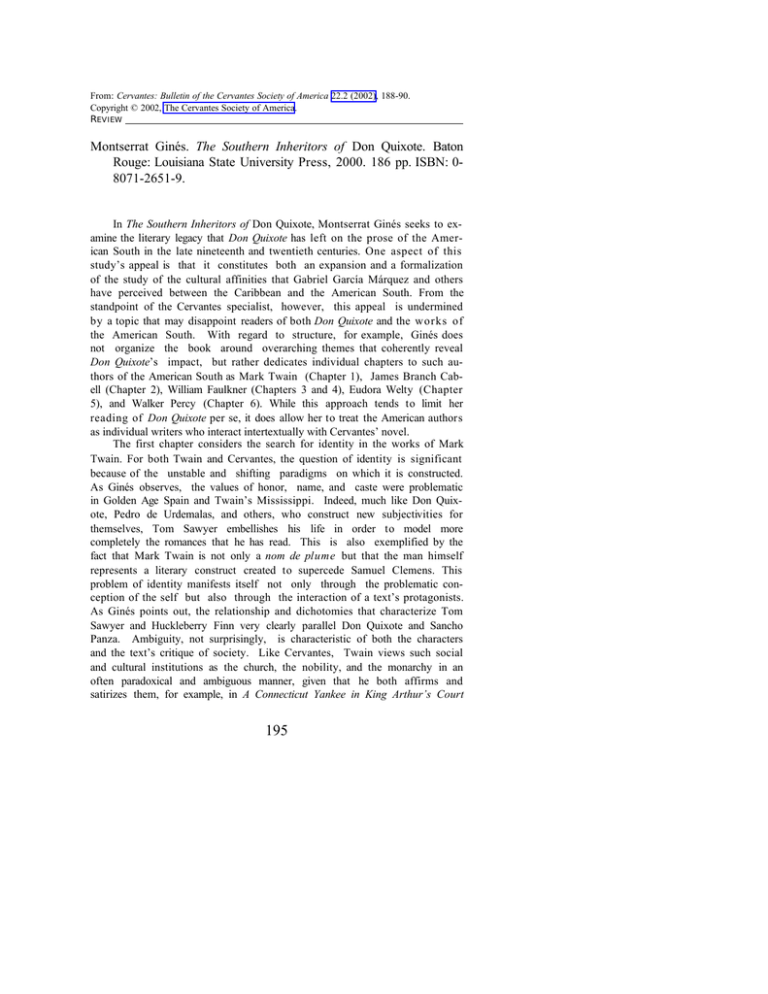
From: Cervantes: Bulletin of the Cervantes Society of America 22.2 (2002), 188-90. Copyright © 2002, The Cervantes Society of America. R EVIEW Montserrat Ginés. The Southern Inheritors of Don Quixote. Baton Rouge: Louisiana State University Press, 2000. 186 pp. ISBN: 08071-2651-9. In The Southern Inheritors of Don Quixote, Montserrat Ginés seeks to examine the literary legacy that Don Quixote has left on the prose of the American South in the late nineteenth and twentieth centuries. One aspect of this study’s appeal is that it constitutes both an expansion and a formalization of the study of the cultural affinities that Gabriel García Márquez and others have perceived between the Caribbean and the American South. From the standpoint of the Cervantes specialist, however, this appeal is undermined by a topic that may disappoint readers of both Don Quixote and the works of the American South. With regard to structure, for example, Ginés does not organize the book around overarching themes that coherently reveal Don Quixote’s impact, but rather dedicates individual chapters to such authors of the American South as Mark Twain (Chapter 1), James Branch Cabell (Chapter 2), William Faulkner (Chapters 3 and 4), Eudora Welty (Chapter 5), and Walker Percy (Chapter 6). While this approach tends to limit her reading of Don Quixote per se, it does allow her to treat the American authors as individual writers who interact intertextually with Cervantes’ novel. The first chapter considers the search for identity in the works of Mark Twain. For both Twain and Cervantes, the question of identity is significant because of the unstable and shifting paradigms on which it is constructed. As Ginés observes, the values of honor, name, and caste were problematic in Golden Age Spain and Twain’s Mississippi. Indeed, much like Don Quixote, Pedro de Urdemalas, and others, who construct new subjectivities for themselves, Tom Sawyer embellishes his life in order to model more completely the romances that he has read. This is also exemplified by the fact that Mark Twain is not only a nom de plume but that the man himself represents a literary construct created to supercede Samuel Clemens. This problem of identity manifests itself not only through the problematic conception of the self but also through the interaction of a text’s protagonists. As Ginés points out, the relationship and dichotomies that characterize Tom Sawyer and Huckleberry Finn very clearly parallel Don Quixote and Sancho Panza. Ambiguity, not surprisingly, is characteristic of both the characters and the text’s critique of society. Like Cervantes, Twain views such social and cultural institutions as the church, the nobility, and the monarchy in an often paradoxical and ambiguous manner, given that he both affirms and satirizes them, for example, in A Connecticut Yankee in King Arthur’s Court 195 196 REVIEWS Cervantes (35–36). Chapter Two addresses the role of self-deception in the works of James Branch Cabell. In Cabell’s work, the reader sees the same preoccupation with humanity’s ability to endorse appearances over reality as in Don Quixote. Notwithstanding his belief that Don Quixote was overrated, Cabell nevertheless emulates Cervantes’ conception of reality as unreliable as well as his concomitant propensity to privilege individual dreams, fantasies, and perceptions. Ginés effectively explores these quixotic themes in many of Cabell’s works, but her most fruitful comparisons focus on The Rivet in Grandfather’s Neck and its protagonist Rudolph Musgrave. This novel centers on the revival of Southern chivalry in the face of an increasingly modern world. Musgrave, like Don Quixote, uses words not as a semantic representation of reality but as a shield from modern “truths.” Consequently, he uses language as symbolic deeds in order to transform his life into an artistic representation of the chivalric code. In the following two chapters, Ginés addresses honor and the quest for utopia as quixotic themes in the works of William Faulkner. Much like Cervantes, Faulkner conceives of honor as a manifestation of moral idealism that conflicts with the realities of the modern world. Protagonists, such as Quentin Compson in The Sound and the Fury, successfully navigate this conflict through their use of abstraction, illusion, and fiction as they attempt to create their own reality. In order to determine the foundation of this utopian “reality,” Ginés turns to Maravall, who associates this utopian quest with traditional heroic ideals, the restoration of the Golden Age, and the rejection of the modern state. The fifth chapter considers the works of Eudora Welty and the nobility of failure. Much like Emma Bovary, the female manifestation of Don Quixote par excellence, Welty’s heroines model the Spanish knight’s desire to change the world without regard for the prospect of failure. This pursuit of change reveals itself as a moral idealism that emerges from the conflict between traditional paradigms and more “modern” ones. Just as the individual conflicts with the collective consciousness, so too, the world of dreams, fantasy, and appearances conflicts with reality. As Ginés insightfully suggests in regard to Welty’s works, one means by which to inform and inspire the individual is art. For Miss Julia Mortimer in Losing Battles and Miss Lotte Elizabeth Eckhart in “The Golden Apples,” art represents a means by which they may dream and forge their own reality as it should be rather than as it is (125–27). The final chapter, on Walker Percy, seeks to establish what may be the most tenuous of connections with Don Quixote. In effect, Ginés discusses how Southern stoicism is emblematic of Percy’s characters, and this leads 22.2 (2002) Reviews 197 her to assert that Will Barrett in The Last Gentleman is indeed the “‘last gentleman’ of Southern fiction” (167). While the consideration of the role of Don Quixote for the Generation of ’98 and the theoretical comparison of quixotic and picaresque protagonists are intriguing, they neither advance the analysis of Percy’s works nor help demonstrate that Barrett’s failed but idealistic pursuit of truth and heroism is inherently quixotic. As suggested in the beginning, from the perspective of the cervantista, the result of Ginés’ commentaries is an often interesting and insightful study that occasionally may leave the reader wondering whether the “inheritance” to which the title alludes really is one of (direct) influence or (indirect) confluence. Although Ginés suggests that the relationship is one of confluence (xiii), she asserts only a few pages later that these writers of the American South “choose Don Quixote as their literary prototype” (6). It seems, in many cases, that Ginés resists the evidence suggestive of the literary influence of Don Quixote in order to attribute it to subconscious cultural factors. This propensity is especially paradoxical in the case of Mark Twain, who, as Ginés points out, praises the Spanish novel in well-known passages in both The Adventures of Huckleberry Finn and Life on the Mississippi. In lieu of discussing intertextuality or the use of Don Quixote as a palimpsest, she affirms that “what concerns us here is not so much proving an influence as showing how Twain’s congeniality with the Spanish author can be related to the particulars of time and place and personal idiosyncrasy from which Twain’s life and work sprang” (17). This insistence upon confluence over influence is also puzzling in the cases of Faulkner, who claimed to have read Don Quixote every year (72), Welty, who considered it one of her favorite books (128), and Percy, who described it as “the first novel and maybe the best” (158). The notable exception is James Branch Cabell who considered the novel overrated (45–46). In light of this aesthetic judgment, the fact that Cabell nevertheless was affected by Cervantes and develops quixotic themes in his work makes the real nature of Don Quixote’s impact all the more intriguing, and may constitute Ginés’ best case for the confluence of cultural factors larger than either writer. In her short conclusion to the book, Ginés attributes the quixotic inheritance to “similar dramatic historical experiences that generate the need for literary expression” in both seventeenth-century Spain and the post-bellum American South (167). While this point constitutes a fruitful line of thinking, the study’s organization effectively s ubordinates such insights on the possible causes and implications of the quixotic phenomenon to the critical analyses of literary texts. As suggested, one of the most significant of such historical factors is the presence of moral idealism painted against the backdrop of social and economic decline. Although Ginés does not explicitly 198 REVIEWS Cervantes make the comparison, the events which may be critical are the defeat of the first Spanish Armada in 1588 and the Confederate loss of the Civil War in 1865. Both events to some degree signal the loss of innocence and the beginning of an extended period of cultural frustration. Critical to this moral idealism, in each case, is the role of chivalry and the characteristics that it values: heroism, Platonic love, honor, hierarchy, paternalism, etc. These insights, more than the critical analyses themselves, are the book’s strength. In conclusion, this short volume is a useful contribution to that complicated field within Cervantine studies that seeks to analyze the cultural impact of Don Quixote throughout western culture. John C. Parrack Dept. of World Languages University of Central Arkansas Conway, AR 72035 johncp@mail.uca.edu
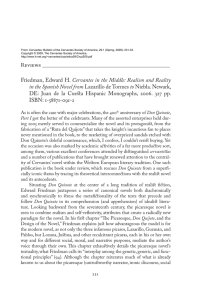
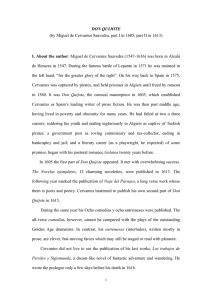
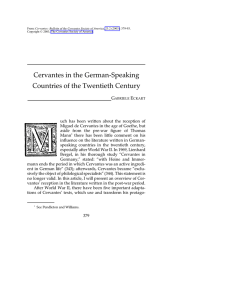
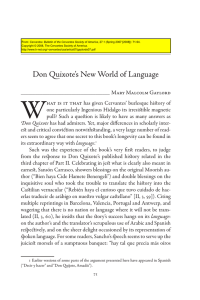

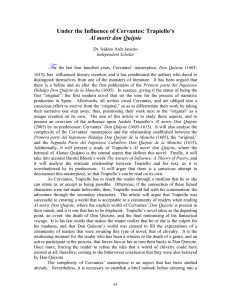
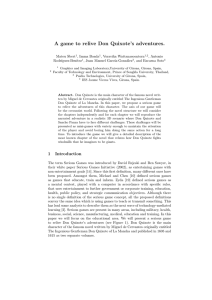
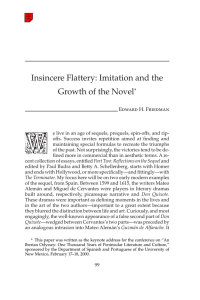
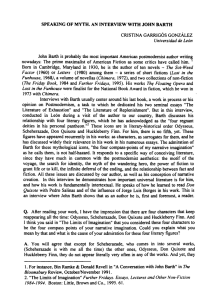
![[Rachel Schmidt] Forms of Modernity Don Quixote (b-ok.org)](http://s2.studylib.es/store/data/008877378_1-b69d60aa900d437bb5b641540463a201-300x300.png)